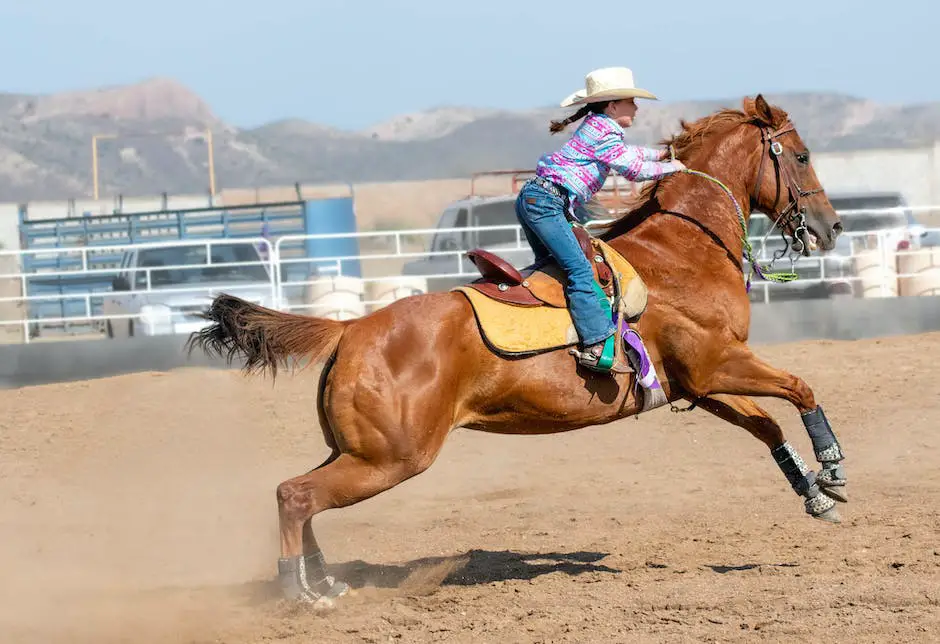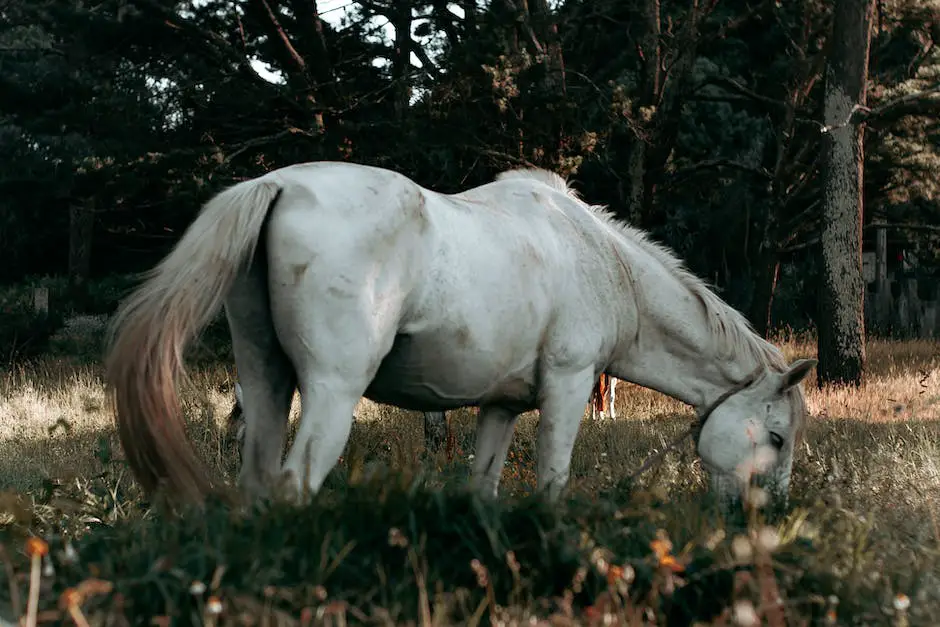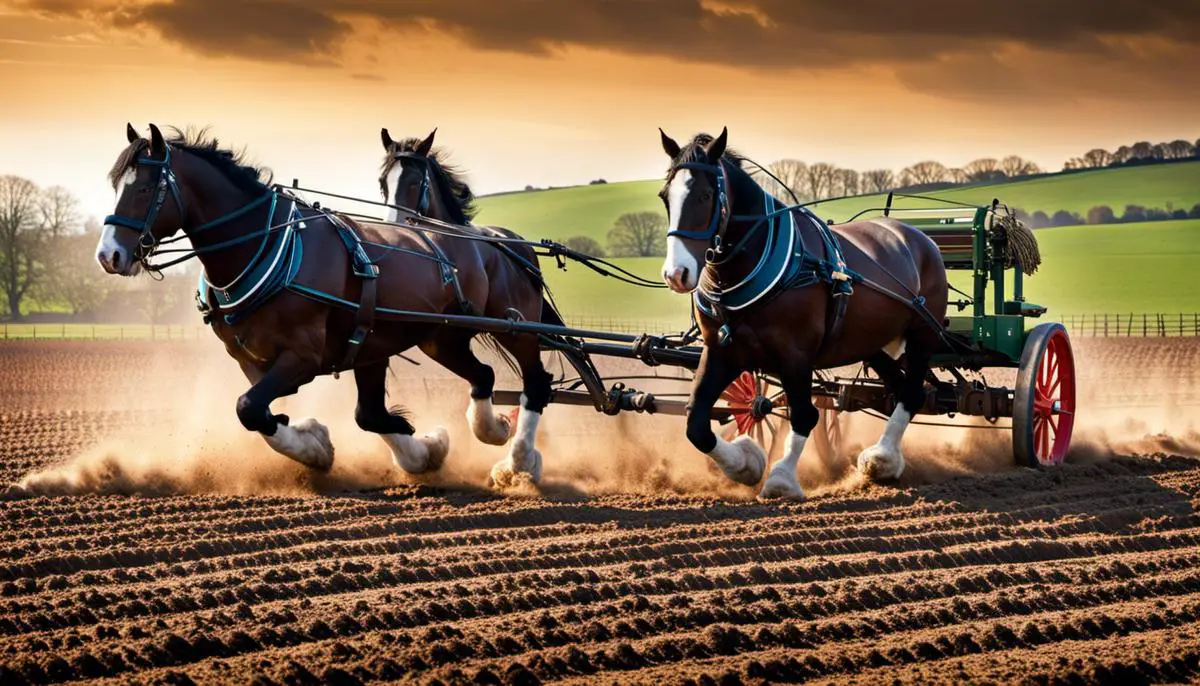Delving deep into the captivating world of equine breeds, two types particularly stand out due to their serenading sturdiness and impressive prowess – the Shire horse and the American draft horse. Emerging from a diverse breeding history and developed for specific needs, these breeds boast distinguished attributes that set them apart from the rest. Our exploration will journey through the timeline of their development, underline their varied physical traits and assess their suitability for different tasks – presenting a comprehensive overview that will not only enlighten enthusiasts but will also bring a better understanding to the general public.
Table of Contents (Horspedia)
Origins & Breeding History
Origins & Breeding History of the Shire Horse
The Shire horse is a British breed, that traces its roots to the medieval war horses known as “Great Horses.” Its history dates back to the 15th century when King Henry VIII set specific requirements for these horses, stating they should stand at a certain height and weight. The Shire horse was initially bred for massive warfare, but by the 17th century, its use shifted towards agricultural work and commercial haulage.
In its heyday during the Victorian era, the Shire horse was commonly used for pulling large shipments of goods, particularly ale, leading to their nickname “the beer horse”. The Industrial Revolution, however, significantly reduced the need for working horses, causing a decline in Shire horse numbers. Despite this, the breed experienced a resurgence in the 21st century, where they are popularly used for exhibitions and decorative purposes.
Origins & Breeding History of the American Draft Horse
American draft horses encompass a variety of horse breeds developed in the United States and are best known for their strengths and bulky structures. Most of these breeds, including the prominent Belgian and Clydesdale breed, descended from horses imported from Europe.
The breeding of American draft horses significantly increased during the 19th century due to an increased need for heavy working horses in farming, logging and other heavy duty applications. In contrast to the Shire horse, the demand for American drafts increased during the Industrial Revolution, as the horses were needed to build America’s infrastructure. Their popularity, however, decreased with the advent of mechanized farming and transportation methods in the 20th century.
The late 20th century saw a resurgence in breeding these horses, which was fueled by a newly found interest in historical farming techniques, horse pulling events, and show exhibitions. Today, the American draft horse continues to be highly revered for not just their strength and size, but also their gentle temperament and work ethic.
Comparing the Shire and American Draft Horse
The Shire and American draft horses share a common history, both bred with an emphasis on strength and endurance, fulfilling roles in war, farming, and hauling. Their popularity ebbed and flowed with the social and economic needs of their time. However, their primary distinguishing factor originates from their geographical backgrounds. Shire horses are native to the British Isles, while American draft horses are a result of various European imports that were bred in the United States. In modern times, members of the equestrian community highly regard both breeds for their historical contribution, raw power, and striking appearances.

Physical Traits & Romant Characteristics
The Shire Horse: The British Gentle Giant
The Shire horse, a breed from the United Kingdom, was specifically fabricated for drawing massive weights. This breed is noted as one of the tallest and heftiest, with standard males towering at a height of 17 to 18 hands (68-72 inches) and tipping the scales at around 2,400 pounds. Females, although typically smaller, remain significantly hefty. Shire horses enjoy a healthy lifespan of 25 to 30 years.
Shire horses showcase a sturdy muscular build, extended powerful limbs, and a hefty frame. Their coat ranges from black, bay, and grey, with ample feathering on the long hairs encircling their hooves. Noted for their gentle and kind disposition, coupled with their formidable power, they are perfect for various roles such as farming, show/parade horses, and delivery horses in breweries.
Given their draft breed profile, the Shire horse isn’t renowned for speed, but they more than compensate with their strength and stamina. Another distinguishing characteristic of these horses lies in the feathery hairs on their lower legs and their long-flowing manes and tails.
American Draft Horse: A New World Powerhouse
American draft horses, also known as American Cream Drafts, are a homegrown breed and the only draft breed developed in the United States. These horses typically stand between 15 and 16 hands high (60-64 inches) and can weigh up to 2,000 pounds. They have a lifespan of 20 to 25 years, slightly less than their Shire counterparts.
Perhaps the most distinguishing feature of the American Cream Draft is their coat color which is a unique cream color, often with white or light cream mane and tail, and pink skin. This breed also has a muscular build with sturdy, strong legs. Still, they are slightly smaller compared to the Shire horses.
American draft horses are reputed for their calm and easy-going temperament. These horses are robust, strong, and well-adapted to a variety of climates and terrains in America. They were commonly used for a variety of heavy tasks, including farming, logging, and pulling heavy loads.
Although American Cream Drafts may not be as large as Shire horses, they possess excellent strength and endurance. They, too, are capable of heavy-duty work and are appreciated for their ability to remain calm under pressure.
Shire and American Cream Draft horses are, without a doubt, renowned for their remarkable strength, versatility in taking up heavy-duty tasks and their calm and amiable disposition. While both breeds bear outstanding attributes, they also possess unique physical traits that make them particularly notable in the arena of horse breeds. It is their size, strength, personality, and distinctive features that have rendered them crucial, not just historically, but also in the contemporary times.

Uses & Suitability for Different Tasks
The Function and Suitability of Shire Horses
Regarded as one of the most colossal and powerful breeds among draft horses, Shire horses are celebrated for their tall stature as well as their exceptional pulling capabilities. Traditionally, these qualities made them the preferred choice for jobs such as ploughing lands, transporting goods, and lugging heavy machinery, making them an integral part of the agricultural landscape. Their typical color variations range from black, bay, or grey and they are easily discernible by the feathers or long hair around their lower legs, that act as a protective shield against harsh weather conditions.
Fast-forward to the modern era, Shire horses continue to maintain their visibility in the realm of heavy horse competitions and routinely feature in demonstration events that showcase their awe-inspiring drafting skills. In addition to their physical prowess, the docile and patient character of Shire horses has led them to be incorporated into therapeutic riding programs.
American Draft Horse Uses & Suitability
American draft horses have been bred for versatility, strength, and endurance. These traits, alongside their typically calm temperament, make them highly suitable for a wide range of tasks. Historically, they were used extensively for agricultural work, transporting goods, and in warfare.
Among American draft horses, breeds like the American Cream Draft and the Belgian are popular. The American Cream Draft, often used for farm labor and heavy freighting, is notable for its cream color, muscular build, and strong resilience to varying climates. The Belgian horse, on the other hand, is stronger and usually used for heavy draft work, though it’s also common in riding and show events.
As with all horse breeds, American draft horses have certain health issues to which they are predisposed. Generally, these large breeds can face musculoskeletal problems, such as arthritis and laminitis, frequently due to their heavy body mass. Breathing problems can also occur due to the size and weight of their respiratory apparatus.
Comparison in Versatility & Work Ethic
Both Shire and American draft horses are respected for their strength, endurance, and work ethic. The Shire’s massive pulling power makes it especially suited for heavy draft tasks, while the American draft horse’s versatility allows it to be put to use in various roles in agriculture, transportation, riding, and shows.
Their temperaments are generally calm and patient, making them well suited to work with people. They are regularly used in therapeutic riding programs for this reason.
In terms of health, both breeds require careful management due to their size and the related potential health problems. Crucial to this is ensuring the horses get appropriate exercise, dietary management, and regular vet checks.
The Shire and American draft horse each have their strengths and potential health concerns, but both represent powerful, versatile, and iconic drafts breeds with a rich heritage and an enduring role in modern times.

Through the lens of history, physical characteristics and suitabilities, we’ve seen the sprawling, profound journey of the Shire horse and American draft horse. Whether it be valiantly marching on battlefields or tirelessly working in agricultural landscapes, these breeds have proven their worth many times over. And yet, these horses are not mere utilities; they are valued companions, often becoming a cherished part of the family. So, let this newfound knowledge foster a deeper appreciation for these competent, charismatic breeds – for their incalculable contributions to our history, our livelihood and our hearts.
